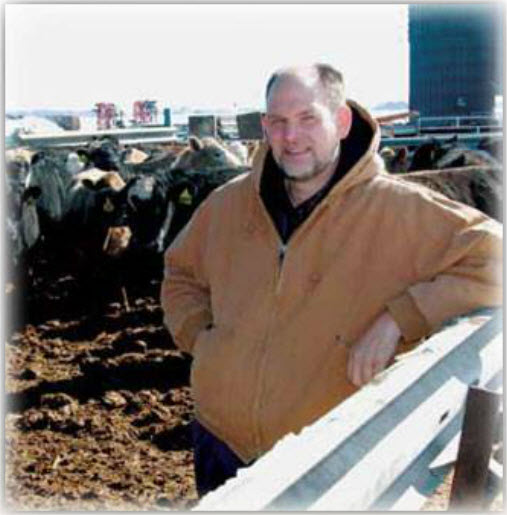
Roy Plote is a sixth generation farmer from Leland. He farms with his brother and brother-in-law raising beef cattle, corn, soybeans, wheat andhay. Roy and his wife, Janet, have two sons, Ethan and Avery.
Q: What’s the difference between grass-finished and grain-finished beef?
A: All beef cattle spend the majority of their lives eating grass. Grass-finished cattle spend their entire life eating grass while grain-finished cattle spend the last 4-6 months eating a ration of grasses, grains and forages.
Since cattle are ruminants, they are well adapted to digest green plant matter, high in fiber, during their lifetime (18-22 months). They can turn a plant that humans can’t eat into food that we can eat.
The USDA definition of grass-finished is “animals that have continuous access to pasture during the growing season and can only consume grass and forage (after weaning)”. Grass and forage options are: orchard grass, timothy, Bermuda, fescue, corn, oats, wheat, barley, sudan, sorghums and other forages such as legumes (alfalfa and clovers).
USDA does not specify or place restrictions on how grass-finished cattle are fed. Animals are not required to be out on pasture constantly. They can be confined and fed by a mixer wagon any combination of the approved feedstuffs. The key to grass-finished beef is to not provide grain regularly.
Feed differences vary based on USDA standards. The plant materials used to feed grass- finished beef must not contain ripened grain. Therefore, silage, haylage, crop residue and pasture grazing are the main sources of nutrients with supplementation of vitamins and minerals, similar to that provided to grain-finished animals.
Grain-finished animals are typically started on grass-fed diets (after weaning, 6-10 months of age) and slowly introduced to grain over time from roughly 600 pounds to market weight. At our feedlot, we feed wet rolled corn that is 30% moisture. The small animals start at five pounds per day and the finish ration is 15-20 pounds per day, depending on how much distillers dry grain soluables (an ethanol by-product), silage or other type of roughage is used.
Market time differs between cattle. A good quality yearling steer (under 20 months of age) that is grain-fed will be ready for market at 1,450 pounds and grade choice or better in 150-170 days, gaining roughly four pounds per day in total body weight.
In comparison, a grass-finished animal will take up to 100 days longer to get to a marketable weight, and my never get to the 1,450 pound target. Another consideration is that after 30 months of age, animal bones become more brittle and when cut, chips of bones can end up in meat, which is not desirable.
Dr. Jude Capper at the University of Washington says grass-finished beef has a larger carbon footprint because of the longer period of time it takes to produce a pound of meat.
Meat taste preferences are subjective. Grain-finished beef vs. grass-finished beef is a matter of taste preference. In my opinion, grass-finished tends to be tougher, some say gamey, as it will pick up the flavors of the fresh grasses and can be more fibrous or stringy. My feeling is this is more due to the age of the animal and lower level of intramuscular fat.
Some claim that grass-finished is healthier due to higher levels of Omega 3. The USDA notes that these differences are not that significant – only about 22 milligrams more in Omega 3 (in a 4 oz. serving) than grain-finished beef.
The key to both kinds of beef is the fat or marbling, which provides flavoring. Fat is fat, fat is flavor, fat provides moisture. It may taste different, but that doesn’t mean its molecular composition is different.
Quality of the beef product can vary. On average, grain-finished beef results in 92% choice or better compared to grass-finished beef which grades 60% choice or better, according to an Iowa State University study. As producers, we strive to raise cattle which grade either prime or choice. Select is the lowest USDA grade of beef.
Bottom line: There are some differences between grain and grass-finished beef animals. To say one is better than another is mostly a matter of opinion.
Click Here To Submit A News Tip Or Story

